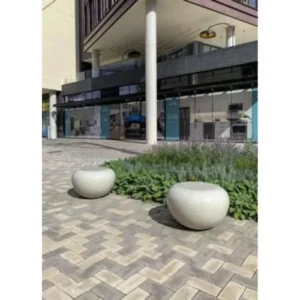Concrete and it's essential role in urban Street Furniture
What is Concrete?
Concrete is a versatile building material that’s made up of three main components: cement, aggregates (such as sand and gravel), and water. When these ingredients are mixed together, they form a paste that hardens over time to create a strong and durable substance.
Common Applications
Concrete is used in a wide range of construction projects, including:
- Buildings: From foundations and walls to floors and roofs, concrete is a staple in building construction.
- Roads and Bridges: Concrete is used to pave roads, highways, and bridges due to its durability and strength.
- Infrastructure: It’s also used in infrastructure projects such as dams, tunnels, and sewage systems.
- Decorative Applications: Beyond structural use, concrete can be polished, stained, or stamped for decorative purposes in driveways, patios, and countertops.
Product Ranges
Concrete is not just limited to traditional construction; it also extends to various product ranges:
- Structural Support Elements: Concrete is commonly used for structural support elements such as beams, columns, and slabs in buildings and bridges. These elements provide the necessary strength and stability to the structure.
- Infrastructure Precast Elements: Precast concrete elements, such as precast panels, beams, and culverts, are manufactured off-site and then transported to the construction site for installation. They offer advantages such as faster construction, quality control, and cost-effectiveness.
- Urban Street Furniture: Concrete is increasingly being used to create urban street furniture such as benches, seaters, planter box, bollards, tree grating, litter bins and bike racks. Its durability and versatility make it ideal for withstanding outdoor conditions while providing functional and aesthetic value to public spaces.
Enhancing Urban Landscapes: The Essential Role of Concrete in Urban Street Furniture
In the bustling streets of modern cities, amidst the hustle and bustle of daily life, one might overlook the subtle yet significant role played by concrete in shaping urban landscapes. Concrete, often regarded as a mundane building material, quietly supports and enhances the functionality and aesthetics of our streets through various forms of street furniture. From benches to bollards, concrete offers durability, versatility, and sustainability, making it an indispensable element in urban design.

Durability for Endurance
When we think of street furniture, durability is paramount. Concrete stands out as an ideal material for enduring the rigors of urban environments. Unlike wood, which can rot or metal, which can corrode, concrete is resilient to weather conditions, vandalism, and heavy usage. This longevity translates to cost-effectiveness for municipalities and ensures that the infrastructure remains intact for years to come.
Versatility in Design
The versatility of concrete allows designers to mold it into various shapes and forms, catering to diverse urban design needs. Whether it’s sleek and modern benches adorning a plaza or robust bollards lining pedestrian walkways, concrete can adapt to different styles and functionalities. Moreover, concrete’s ability to be colored and textured provides endless design possibilities, enabling designers to integrate street furniture seamlessly into the surrounding environment.
Sustainability at its Core
In an era where sustainability is a pressing concern, concrete emerges as a sustainable choice for street furniture. Concrete is composed of readily available materials such as sand, gravel, and water, reducing the environmental impact associated with sourcing raw materials. Additionally, its durability minimizes the need for frequent replacements, further reducing resource consumption and waste generation. With advancements in concrete production techniques, such as incorporating recycled materials or using low-carbon cement, concrete street furniture contributes to a more sustainable urban infrastructure.
Functionality Meets Comfort
Street furniture serves not only as aesthetic embellishments but also as functional amenities for urban dwellers. Concrete benches provide comfortable seating for pedestrians to rest and socialize, fostering community engagement and enhancing the overall street experience. Similarly, concrete planters not only add greenery to urban spaces but also serve as barriers, delineating pedestrian zones from vehicular traffic, thus promoting safety and walkability.
Integration with Smart Urban Solutions
As cities evolve towards becoming smarter and more connected, concrete street furniture can seamlessly integrate with various smart urban solutions. Embedded sensors in concrete benches or waste bins can provide valuable data on foot traffic patterns or waste management, enabling municipalities to make informed decisions for urban planning and resource allocation. Furthermore, incorporating charging stations for electric vehicles into concrete structures aligns with the growing trend towards sustainable transportation infrastructure.
In conclusion, concrete plays a multifaceted role in shaping urban landscapes through street furniture. Its durability, versatility, sustainability, and functionality make it an indispensable element in urban design. From providing enduring seating solutions to contributing to smart urban solutions, concrete street furniture enhances the aesthetic appeal, functionality, and sustainability of our cities. As we continue to innovate and adapt to the evolving needs of urban environments, concrete remains a steadfast ally in creating vibrant and resilient streetscapes for generations to come.
At Fast Concrete Products, we understand the importance of concrete in urban design and offer a range of high-quality concrete products tailored to meet the diverse urban street furniture needs of modern cities. Contact us today to explore how our concrete solutions can elevate your urban landscape.
